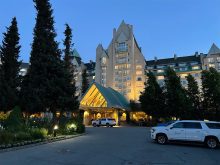Artists and those who commission their work usually want as many people as possible to see their masterpieces.
Art galleries big and small dot the prairie landscape, all with the express purpose of making art accessible to the general public.
And then there are all those giant roadside attractions that eager prairie communities have set up over the years to promote themselves. Many people might not think of these as art, but I beg to differ.
In Alberta, there’s the giant pysanka at Vegreville and the replica of the starship USS Enterprise from the Star Trek TV show in Vulcan.
Read Also

Downturn in grain farm economics threatens to be long term
We might look back at this fall as the turning point in grain farm economics — the point where making money became really difficult.
In Saskatchewan, there’s Mac the Moose in Moose Jaw and the world’s largest oil can in Rocanville.
In Manitoba, there’s a giant mosquito in Komarno and the world’s largest painting on an easel (Van Gogh’s Sunflowers) in Altona.
This is just a quick sampling of the many similar attractions that can be found across the Prairies, and what they all have in common is that someone wants them to be seen.
The same priority doesn’t seem to have been part of the thinking when a giant art installation appeared in the Qatari desert eight years ago.
The oil-rich country, which is said to spend $1 billion a year on public art, commissioned a piece from internationally acclaimed artist Richard Serra.
What he came up with were four 14-metre-tall steel plates erected in the sand and marching across the desert for a kilometre.
The installation, called East-West/West-East, is said to be awe-inspiring, if you can get there.
The site is located about an hour’s drive from Qatar’s capital, Doha, far out into the desert. There are no roads, signs or maps. Prospective viewers are given nothing but GPS co-ordinates.
I recently read a hair-raising account by a sports writer who was in Qatar covering the World Cup and decided to visit the installation. It didn’t help that the driver he hired took a small Kia rather than an off-road 4 x 4.
They made it, though, and by all accounts the adventure was worth it.
For me, however, I’d rather stop and take a look at Quilly Willy, the big porcupine of Porcupine Plain, Sask., any day of the week.

















